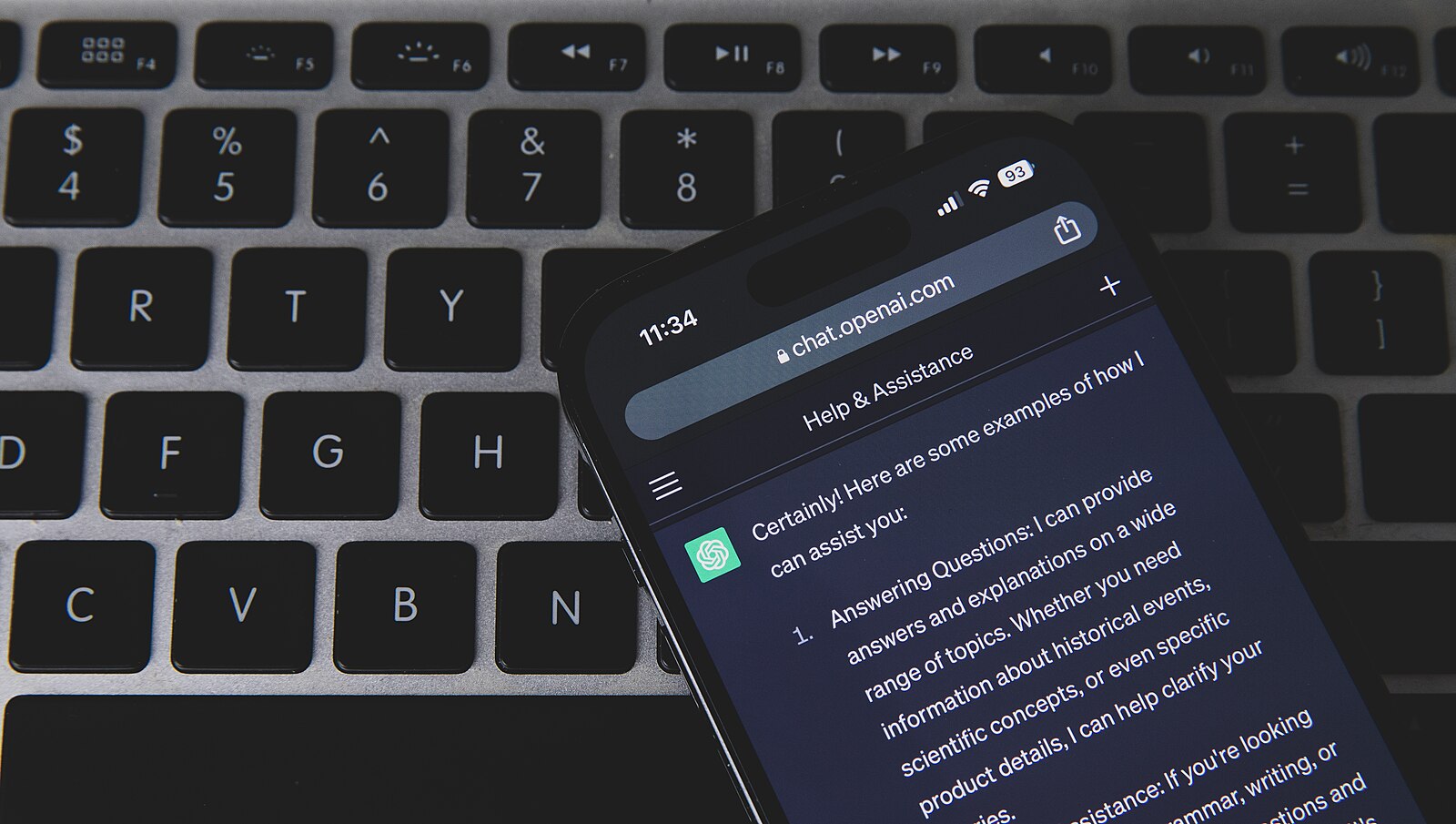
[Image source: wikipedia.commons.org https://commons.wikimedia.org/wiki/File:Mobile_phone_with_ChatGPT_on_keyboard_(52916924616).jpg]
Headlines have always been an important tool in journalism. In print media, it serves as a short summary of the story, and in the digital age, headlines have become a key factor in engaging the audience. Readers view headlines five times more often than the main text, making them the most influential element of a news story. At the same time, clickbait, as one of the most popular tools in digital media, often undermines readers’ trust. Emotional “hooks” and sensationalism in AI headlines are effective in attracting attention, but can lead to the spread of misinformation. In contrast, headlines created by journalists are more trustworthy due to a deeper understanding of the context and adherence to ethical standards.
In Central European countries, such as Poland, the Czech Republic, and Slovakia, the use of AI in the media is limited to simple tasks such as editing texts or automatically generating short news stories and headlines. Around 15% of media organisations in the region are actively using AI, but most newsrooms are cautious about automation, seeking to preserve the ethics and quality of journalism.
The success of AI in creating headlines raises a new scientific question: how exactly do algorithms achieve such efficiency? “What can be automated will be automated,” predicts Danish researcher, Aryen van Dalen, but emphasises the indispensability of humans in building trust and creating content that resonates with the audience. Thus, AI becomes not a replacement, but a tool that frees up journalists’ time to work on the quality and veracity of materials.
How to study the impact of headlines
Romanian researchers selected 100 articles from five leading Romanian media outlets from the RoCliCo database (8000+ headlines). For each article from Digi24, Libertate, ProTV, WOWBiznewspaper, and Vivamagazine, ChatGPT created two variants of headlines: clickbait and informative. A total of 624 students from the universities of Timisoara (Romania) evaluated these headlines for a month via an online platform. The young audience was deliberately chosen as the main target group for online media. Participants evaluated three headlines for each article.
Over 80% of students said that headlines play a key role in their decision to read an article. The most important characteristics of headlines were clarity and relevance to the content: 54.9% recognised these aspects as extremely important. The ability of headlines to grab attention and convey key information was also highly valued. At the same time, shocking or overly emotional headlines received significantly less support, demonstrating that the audience prefers content over sensationalism.
The study showed that headlines created by ChatGPT in the clickbait style were the most effective in attracting readers’ attention, receiving 37.5% of positive ratings. Informative headlines, also created with ChatGPT, came in second with a score of 33.4%, indicating a high demand for transparency and accuracy among the audience.
Original article titles scored the lowest engagement rate of only 29.2%, indicating their lower effectiveness compared to AI-generated versions.
Lexical and grammatical characteristics of ChatGPT titles
The analysis of linguistic features of clickbait headlines generated by ChatGPT showed that their effectiveness is based on grammatical and lexical techniques that evoke emotions, stimulate curiosity, and create a sense of urgency. For example, the use of emotionally coloured words, interrogative structures, and ellipsis activates the reader’s cognitive processes, attracting their attention.
Grammatical structures, in particular the present tense, create the effect of urgency, and the thematic organisation of the text and metaphors not only maintain intrigue but also enhance the emotional response.
Stylistic features also play a key role in creating clickbait headlines. The use of metaphors, direct addresses to the reader, and informal tone adds vibrancy to the headlines and engages the audience. The methods described by Lakoff and Johnson in their book Metaphors We Live By show how metaphors influence perception and stimulate emotional interaction. At the lexical and grammatical levels, clickbait headlines rely heavily on dynamic verbs, dramatic nouns, emotional adjectives, and specific linguistic structures to grab readers’ attention. These feature work synergistically to create urgency, intrigue, and emotional engagement.
Verbs and verb structures
Dynamic verbs, such as “threatens,” “explodes,” and “declares,” are commonly used in clickbait headlines to evoke urgency and drama.
For example, the headline “Putin Threatens Preemptive Strikes! Russia may launch its first nuclear strike by changing military doctrine!” uses strong verbs that indicate imminent danger, drawing readers in.
Likewise, modal verbs like “may ” introduce uncertainty, encouraging speculation and curiosity. Another example, “The popularity of pro-Russian extremists in Bulgaria is growing!” combines dramatic verbs with vivid imagery to intrigue the reader. Phrases such as “draw a red line” or “bring to justice” add a layer of tension, hinting at conflict or mystery. For example, “Olaf Scholz declares: Russia has abandoned its nuclear plan! Find out how the international community has drawn the red line!” combines revelation with intrigue, effectively engaging the audience.
The nouns are carefully chosen to enhance emotional weight and intrigue.
Terms such as “scandal,” “catastrophe,” “truth,” and “mystery” evoke a strong reaction by emphasising sensationalism or promising hidden information.
For example, “Scandal at the customs! Romanian customs officers, accomplices of the international tobacco fraud network, exposed!” highlights dramatic events. The use of such nouns creates a sense of exclusivity, hinting that the reader is getting access to valuable, hidden knowledge, which increases their engagement.
Adjectives and adverbs
Adjectives and adverbs add emotional intensity to headlines and dramatise events. Words such as “shocking,” “impressive,” and ‘incredible” increase the impact of the message. For example, “Gigi Becali’s shocking €800,000 donation to a church in Africa! Find out why he chose Rwanda!” combines an amazing event with an invitation to learn more, increasing curiosity.
Higher degrees of comparison, such as “the worst,” “the oldest,” or “the strongest,” emphasise the uniqueness and exclusivity of the content.
For example, in the headline “At 106, Apo Wang-Od becomes the oldest model on the cover of Vogue – a story that stunned the world!” the emphasis on the extraordinary achievement adds an emotional charge. These elements make headlines not only compelling but also memorable.
Numbers and exclamation points
Numbers add clarity, specificity, and a sense of authenticity, making them a powerful tool in clickbait. For example, the headline “Tutankhamun’s hidden face revealed after 3300 years! You won’t believe what the legendary pharaoh looks like!” uses an exact number to emphasize the significance of the discovery. Likewise, “Insurance bankruptcy disaster: over 1.6 billion lei lost, huge risks for customers!” combines digital data with dramatic language to enhance the emotional impact of the headline.
Exclamation points are often used to convey shock, urgency or excitement. For example, the headline “Romania betrayed by joining Schengen! Manfred Weber is outraged: “It’s not fair! ” combines emotional vocabulary with expressive punctuation to enhance the drama. This approach creates the impression that the event is extraordinary and requires the reader’s immediate attention.
By combining lexical and grammatical features with stylistic devices, clickbait headlines successfully manipulate readers’ emotions and curiosity, stimulating greater engagement and interaction. Thus, AI’s linguistic creativity is becoming an important means of attracting audience attention, reflecting the trends in digital media.
This article was originally published on: https://ua.ejo-online.eu/ Read the original article here: https://ua.ejo-online.eu/8893/tsyfrovi-media/khto-krashche-pyshe-zaholovky
The views expressed on this site are those of the authors and do not necessarily reflect the views, policies, and positions of the EJO.








































